Kyoto University maintains numerous facilities for research and education across the country, from Hokkaido in the north to Kyushu in the south. While these have served as important bases for the university's wide range of distinctive academic activities, they also play the role of "Windows of Kyoto University", opening doors to the institution -- via public events over the course of many years -- for residents of surrounding communities.
Kyoto University Weeks 2014 included activities at 23 such sites, a larger scale than in the previous years, newly introducing the Hida Observatory, Kamitakara Earthquake Observatory, and Hodaka Sedimentation Observatory. A total of 6,472 people attended the venues during the course of the event.
- Official website (in Japanese):
http://www.kyoto-u.ac.jp/ja/social/events_news/office/syogai/news/2014/141108_1.html
Kyoto University Weeks 2014 public events
1. Hida Observatory: Tour to rediscover nature (11-13 October 2014)
Hida Observatory of the Graduate School of Science held a "rediscovering nature tour" for three days and two nights.
Taking advantage of good weather for the first two days, participants enjoyed gazing at galaxies and the face of the moon using Asia's largest refractor telescope, making naked-eye observations of the clear night sky and the Milky Way, and observing sunspots, prominences, and optical spectra using the Domeless Solar Telescope and the Solar Magnetic Activities Research Telescope. The participants gave various feedback, such as "I really understand that how clearly we can see the stars depends not just on the power but the size of the telescope" and "I learned the shape and the structure of the Milky Way for the first time". This event gave the participants an opportunity to enjoy a scientific perspective on the grandeur of nature, something which they typically do not experience in their daily lives. The planned program on the third day was partially changed due to an approaching typhoon.
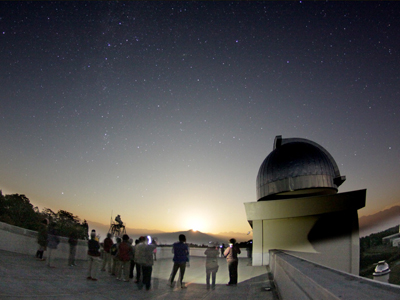
Observing the starry sky and the Milky Way
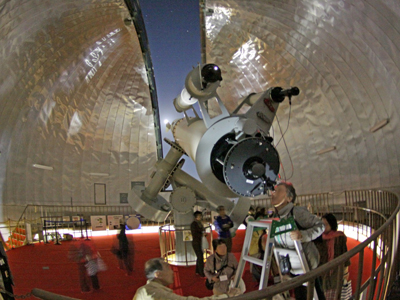
Taking turns observing the face of the moon using Asia's largest refractor telescope (inside diameter 65 cm)
- Kwasan and Hida Observatories website: http://www.kwasan.kyoto-u.ac.jp/index_en.html
2. Maizuru Fisheries Research Station: Exhibition "Wonder of marine life in the Wakasa Bay" and facility tour (11-12 October)
Maizuru Fisheries Research Station of the Field Science Education and Research Center held an exhibition and a facility tour in order to publicize its activities to the public.
The event to introduce the facility was held at the Research Station for the first time this year. In previous years, the event had been held at a rented venue as part of series of events organized by the city of Maizuru. In the aquaculture unit, visitors saw the actual research site and touched marine animals living in Maizuru bay at a space specially set for the event. At the specimen storage unit, rare species such as giant oarfish and a double stain skeleton were exhibited. The visitors also observed plankton and observed a learning experiment of sea breams. The tour was conducted three times each day, in which facility staff explained about the Station to the participants. The tour was so popular that almost every time was filled to capacity. Most of the participants had visited the Station for the first time and gave various positive feedback, such as "I didn't even know that Kyoto University has a facility here", "I am overwhelmed by the fish specimens numbering as many as 300,000", and "I gained a great and unique experience".
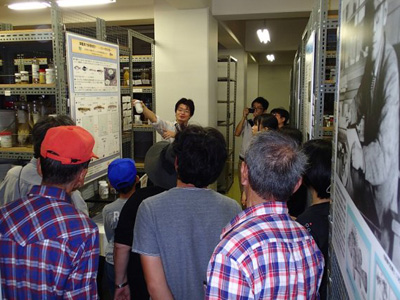
Facility tour at the specimen storage unit
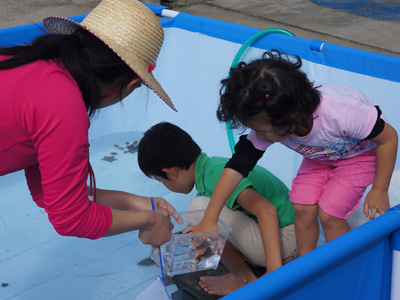
Participants touching marine animals from Maizuru bay
- Maizuru Fisheries Research Station website: http://www.maizuru.marine.kais.kyoto-u.ac.jp/en/
3. Shirahama Oceanographic Observatory: Observation of marine phenomena from an ocean station vessel (11 October)
Three residents from Osaka and Wakayama Prefectures took part in a marine phenomena observation event sponsored by the Shirahama Oceanographic Observatory.
After briefings on activities related to the Tanabe-Nakajima storm surge observation tower and the observatory ship Kaisho, participants boarded the ship and sailed out to the tower, where they made oceanic observations and measured water temperature and salt levels. Afterward a participant remarked, "I enjoyed the rare experience of conducting fieldwork related to sea water on board a ship. If you hold this kind of event again, I will definitely sign up".
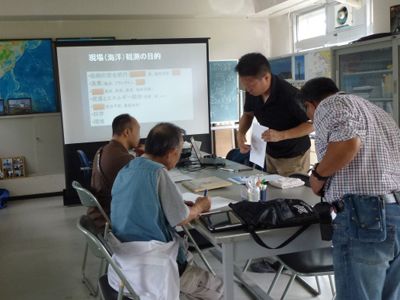
Briefings at the observatory
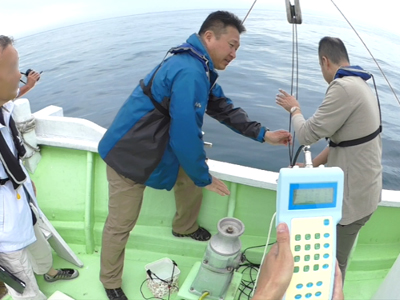
Making measurements near the observation tower
- Shirahama Oceanographic Observatory website: http://rcfcd.dpri.kyoto-u.ac.jp/frs/SOO_E.htm
4. Kamitakara Earthquake Observatory and Hodaka Sedimentation Observatory: Joint public event for Kyoto University Weeks 2014 (18 October)
Two observatories of the Disaster Prevention Research Institute held a joint public event for Kyoto University Weeks 2014.
First, two lectures on Mt Yake's volcanic activity were delivered at the main venue, the branch office of the city of Takayama. Afterward, interested participants took a 5 km bus ride to the Kurabashira observatory tunnel, where they toured the observatory. Participants came not only from the town of Kamitakara, but also from Takayama, Matsumoto, Nagoya, and Kobe. Kamitakara residents seemed impressed by the tour, saying that they had not known that such a facility existed in their neighborhood.
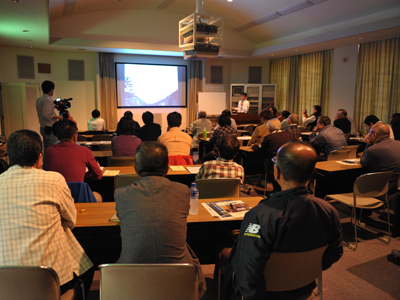
Lecture scene
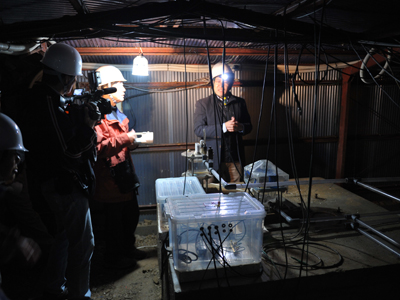
Explanation of the watertube tiltmeter in the Kurabashira observatory tunnel
- Kamitakara Earthquake Observatory website: http://www2.rcep.dpri.kyoto-u.ac.jp/observatory/ktj/index.html (Japanese text only)
- Hodaka Sedimentation Observatory website: http://www.okuhida-dsl.com/kansoku/EHodaka.html
5. Center for Ecological Research: Public program "The wonder of natural life forms that you never study at school" (18 October)
The Center for Ecological Research held a public program beginning with a briefing by Professor Shinichi Nakano, Director, about current projects, followed by lectures by two teaching staff: "For whom flowers bloom?", and "How human and natural life forms are related". Next, a number of participants conducted nature observation in the Forest of the Center for Ecological Research (CER's Forest). As in the previous year, a variety of people ranging from children to retirees coming from a wide range of communities joined the event.
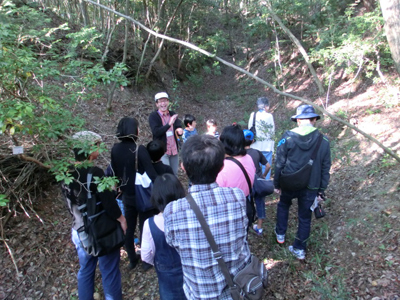
Nature observation session in the CER's Forest
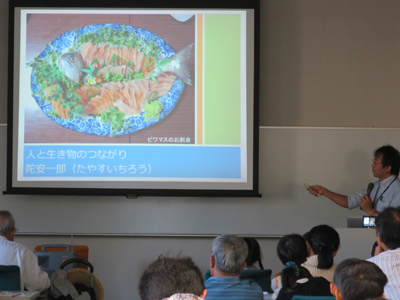
Lecture "How human and natural living forms are related"
- Center for Ecological Research website: http://www.ecology.kyoto-u.ac.jp/ecology/english/index.html
6. Shigaraki MU Observatory: Tour to learn about the Shigaraki MU radar study of the middle and upper atmosphere (18 October)
Shigaraki MU (middle and upper atmosphere) Observatory of the Research Institute for Sustainable Humanosphere has one of the most powerful atmospheric observation radars in the world, which has been collaboratively used by researchers in Japan and around the world since its completion in 1984. And annually since 2011, public study tours have been held.
For 2014 the tour was held twice, once in the morning with 85 participants and then in the afternoon with 84. Following a lecture by Professor Mamoru Yamamoto of the Research Institute for Sustainable Humanosphere, participants toured the MU radar and related facilities, and watched live balloon observation being conducted. The fine weather increased the satisfaction and enjoyment of the participants throughout the day.
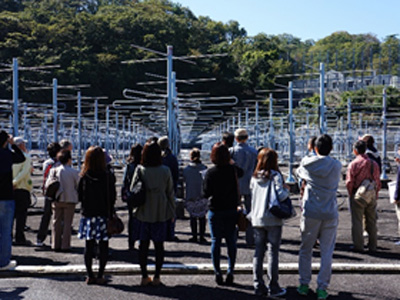
Study tour of the MU radar antenna consisting of 475 Yagi antennas
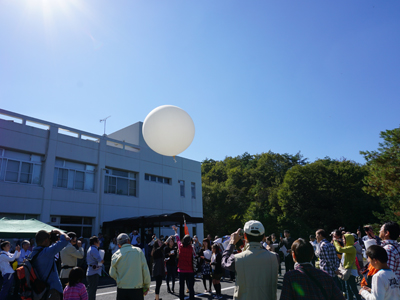
Participants counting down to the release of the observation balloon
- Shigaraki MU Observatory website: http://www.rish.kyoto-u.ac.jp/mu/en/index.html
7. Sakurajima Volcano Research Center: 101 projects marking the 1914 Sakurajima Eruption (18-19 October)
Sakurajima Volcano Research Center of the Disaster Prevention Institute held facility tours on 18 and 19 October, along with a public program at the facility on the 19th.
In the facility exploration bus tours, 85 people participated in total. In the Harutayama observatory tunnel, which ordinarily is closed to the public, a brief lecture was given on the observation equipment and the role of the observatory tunnel, resulting in a number of questions from participants. Next the groups visited the Harutayama observatory, the former Sakurajima Observatory, where from the roof they were able to see Sakurajima close at hand. Following a lecture on the steep Kita-dake (northern peak) just in front of them, volcanic activity of Minami-dake (southern peak), and Aira Caldera and Kinkou Bay, they took a look at a mechanical seismometer and a barometer that have been in use for more than half a century. Finally, they observed the active Showa crater from Kurokami observatory.
In the public event at Sakurajima observatory, particularly popular programs included: an exhibition of pictures and footage of Sakurajima eruptions from the Taisho era to today, a seismograph using smoked paper on rotating drums, which has been used since the observatory opened, and an explanation on the cutting-edge data-processing equipment being used to forecast eruptions.
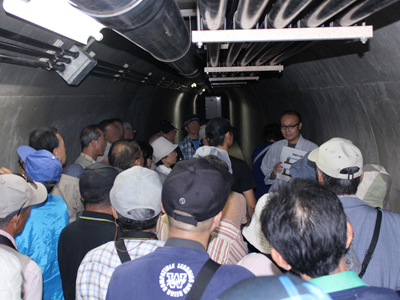
Facility exploration tour: Participants listening to an explanation of a measuring device in the Harutayama observatory tunnel
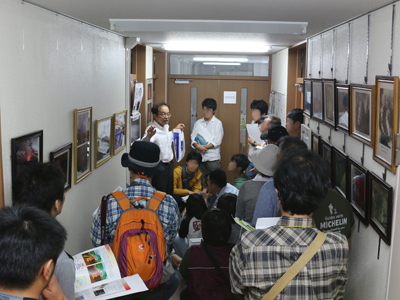
Public event at the facility: Learning about ground-deformation data taken prior to an eruption
- Sakurajima Volcano Research Center website: http://www.svo.dpri.kyoto-u.ac.jp/default_e.html
8. Hokkaido Forest Research Station Shirakaba Branch: Mini public program to observe nature (19 October)
Hokkaido Forest Research Station Shirakaba Branch of the Field Science Education and Research Center held a nature observation session, in which 13 participants took part.
Following the opening ceremony and a briefing held at the administrative office, participants traveled by car to a trail in the forest to observe nature. Two groups of participants then slowly walked along the path, listening to explanations by the teaching staff and technical personnel. As the fall colors were even more beautiful than usual, many participants expressed their joy in joining the event.
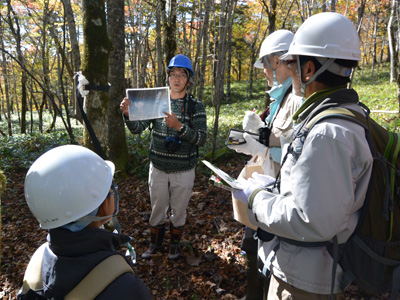
Briefing by teaching staff
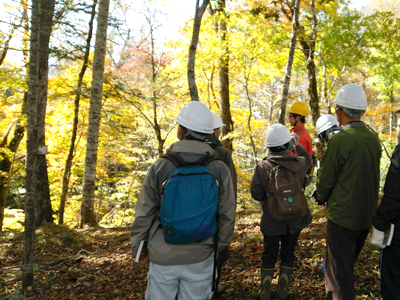
Participants observing the autumn foliage
- Hokkaido Forest Research Station website: http://fserc.kyoto-u.ac.jp/wp/hokkaido/ (Japanese text only)
9. Research Reactor Institute: "Atom Science Fair" experiment session and lectures (19, 25 October)
"Atom Science Fair" aims to enable a broad age range of people to become familiar with and interested in science.
In one session, participating children conducted experiments such as with a cloud chamber and trying their hands at motor fabrication, after which they expressed their satisfaction with understanding what makes science interesting. On 25 October two lectures, "The world of the research reactor" and "The world of accelerators", were delivered to an attentive audience. Among the participants, the number of high school students was the highest ever, and many asked thoughtful questions.
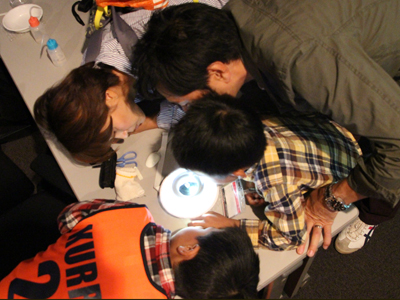
Experiment session "Let's make a cloud using radiation"
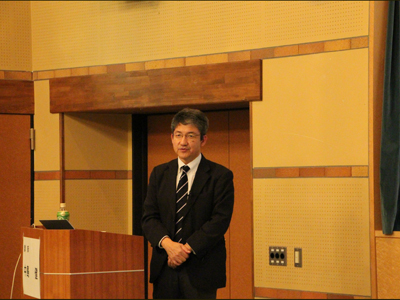
Lecture scene
- Research Reactor Institute website: http://www.rri.kyoto-u.ac.jp/en
10. Kwasan Observatory: "Galleryweek 2014", public programs, and a facility tour for Kyoto city primary school students (24-26 October, 1 and 4-8 November)
Kwasan Observatory held three types of events during Kyoto University Weeks 2014: "Galleryweek 2014", public programs, and a facility tour for primary school students from Kyoto city.
For Galleryweek 2014, a variety of space-inspired works of art were exhibited at the observatory. At the public programs, an exhibition and briefing on telescopes and observation equipment, a round-table talk, and a demonstration of a 4D-theater were held. A stargazing session using a 45 cm refractor telescope was also scheduled at night, but then cancelled due to bad weather. The Kyoto city school children's tour hosted students from nine schools in cooperation with Kyoto City Board of Education.
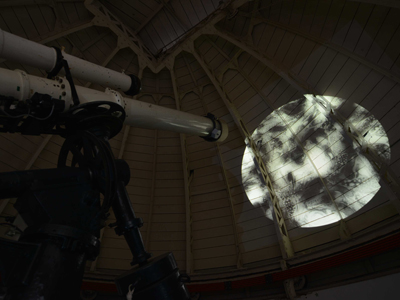
Work of art projected on the inside of the dome for "Galleryweek 2014"
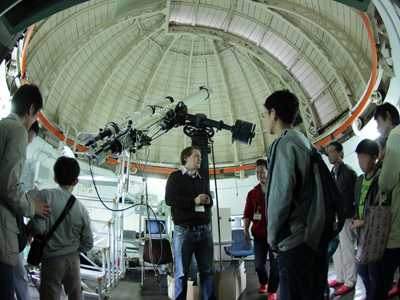
Briefing on the Sartrius telescope (18 cm refractor telescope) in the public program event

Briefing on the coelostat telescope for primary school students
- Kwasan and Hida Observatories website: http://www.kwasan.kyoto-u.ac.jp/index_en.html
11. Aso Volcanological Laboratory: Lecture commemorating the registration of the laboratory building as a tangible cultural property, and other public programs (24-25 October)
Aso Vocanological Laboratory held a lecture to commemorate the registration of the laboratory building as a tangible cultural property on 24 October, as well as public programs the following day in cooperation with Minamiaso Village Board of Education. These events aimed not only to publicize the university's activities and volcanological study in general, but also to strengthen ties between the university and the local community. The occasion of the registration of the laboratory's main building as a national tangible cultural property provided context for the events.
On the first day, two lectures were given: "Let's discover a planet outside the solar system using the Kyoto University telescope", and "Volcanic activity and changes in hot springs: learning from the 2000 eruption of Mt Usu in Hokkaido". Staff at the laboratory also briefed participants about research activities using posters exhibited at the venue. The number of people attending totaled 250, including 170 students from local junior-high schools.
On the second day, a presentation was given on the history of the laboratory, posters showing cutting-edge study on volcanology were exhibited, and observation experiments were demonstrated as part of public programs attended by 80 people including some parents with children. One participant remarked, "It was interesting to see how observations are conducted. I would like to come again next year".
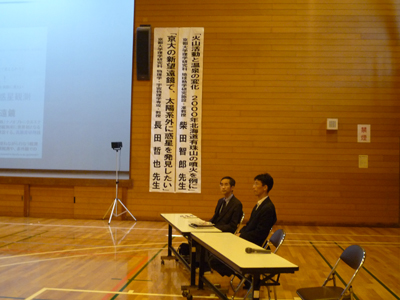
The lecturers
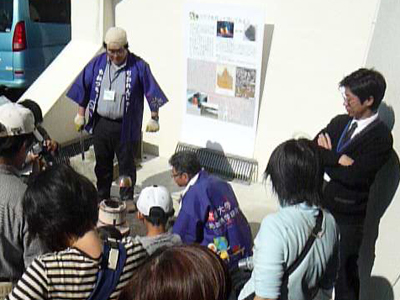
Modeling magma by using a 'shichirin' charcoal stove
- Aso Volcanological Laboratory website: http://www.aso.vgs.kyoto-u.ac.jp/menu/index.html (Japanese text only)
12. Uji Campus: Open Campus 2014 "Science for Everyone" (25-26 October)
Under the theme of "Science for Everyone", the Uji Campus hosted the public for 24 events over two days, including special lectures and open laboratories.
Every year, the Uji Campus has opened its doors to the public for a variety of programs appealing to a wide range, from young children to seniors, including the opening of research facilities and laboratories that are ordinarily closed to visitors. The number of participants has increased annually, exceeding 2800 in 2014. A concurrent stamp rally was also very popular among participants, who enjoyed the clear autumn weather. Uji Campus plans to continue such events involving the local community.
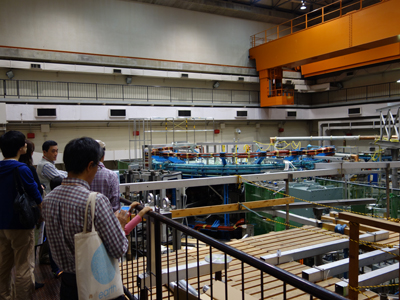
The unnoticed world of plasma around us
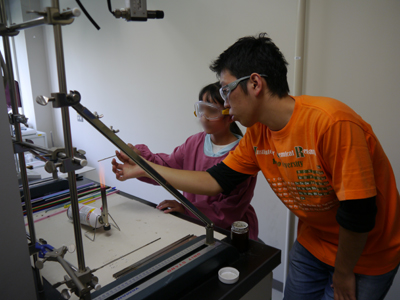
Experiencing glass beadmaking
- Uji Campus website: http://www.uji.kyoto-u.ac.jp/english/index.html
13. Seto Marine Biological Laboratory: Facility tour (25 October)
Seto Marine Biological Laboratory of the Field Science Education and Research Center (FSERC) held a tour of the facility, attended by 18 people.
Following an opening address by Professor Akira Asakura, Center Director, participants were ferried to the research and training boat "Yanthina" to travel to Hatakejima island, which serves as the field site for experiments. Following a briefing about the environment on the island, laboratory staff divided the participants into two groups: one to continue the tour, and the other to hike up Hatakejima hill to see a monument in commemoration of the Showa Emperor's visit. Due to the unexpectedly high level of the tide, participants had to walk in knee-deep water to get to reach the ferry. All the participants and staff united to overcome this obstacle, and eventually returned safely to the laboratory.
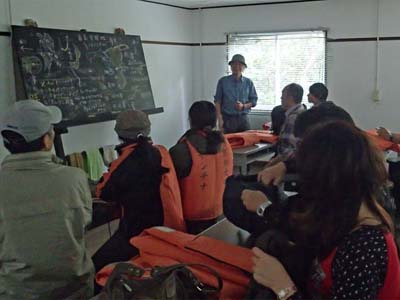
Briefing about the island of Hatakejima
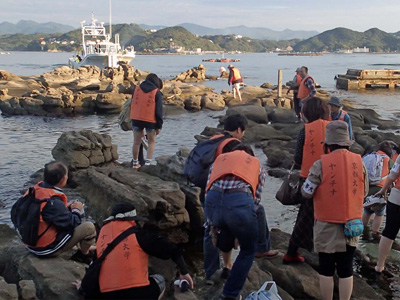
Participants going barefoot to cross the sea at high tide
- Seto Marine Biological Laboratory website: http://www.seto.kyoto-u.ac.jp/e-index.html
14. Tokuyama Experimental Station: Public lecture co-hosted by the Field Science Education and Research Center (FSERC) and Shunan city (25 October)
The Field Science Education and Research Center (FSERC) and city of Shunan co-hosted a public lecture at the Tokuyama experimental station as part of Kyoto University Weeks 2014.
The event included a tour of the current experimental station, as well as a visit to the western forest preserve, where the former research station stood prior to its relocation in 1966. Participants listened to briefings about trees that had been collected from across Japan and also from abroad. Talks in the morning were delivered by two teaching staff of FSERC, and in the afternoon by two guides for the western forest preserve. Some participants said, "The explanations by the experts were very interesting and approachable. If such an event is held again, I would like to participate".
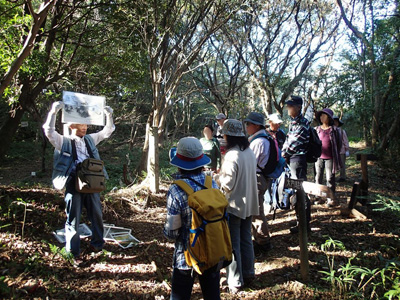
Explaining the historical heritage of the western forest preserve
<img alt="





